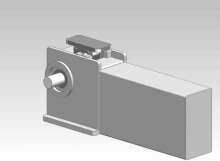Linearantrieb
Als Linearantrieb oder Linearantriebssystem werden alle Antriebssysteme bezeichnet, die zu einer translatorischen Bewegung führen. Linearantriebe ermöglichen die Bewegung von Maschinen(elementen) und Anlagen(teilen) in gerader Linie oder einem anderen vorgegebenen Verlauf.
Beispiele:
- Hebezeug
- Winsch
- Zahnstange
- Schubkette

Schubkette - Zugmitteltrieb
- Kurvenscheibe
- Piezomotor
- Faltspindel
- Gewindespindel

Elektrozylinder
- Kugelgewindetrieb
- Rollengewindetrieb
- Hydraulikzylinder
- Pneumatikzylinder
- elektromechanischer Linearantrieb
- Linearmotor mit elektrodynamischem Wirkprinzip
- Linearaktor
- mit piezoelektrischem Wirkprinzip
- mit elektrostatischem Wirkprinzip
- mit elektromagnetischem Wirkprinzip
- mit magnetostriktivem Wirkprinzip
- mit thermoelektrischem Wirkprinzip.
Der maximale Stellweg von Linearantrieben kann durch eine Reihenschaltung mehrerer Antriebe wie in Teleskopantrieben vergrößert werden.
Mit Linearantrieben lassen sich auch nicht-lineare Bewegungen erzeugen, z. B. über Kurbelwellen oder mit Hilfe eines Hexapoden.
Literatur
- James G. Humphrys: Electromechanical linear actuators solve specific application problems. Actuator Systems, Intertec Publishing Corp., Overland Park, November 1979, S. 26–31
Auf dieser Seite verwendete Medien
A conceptualized model of a simple electro-mechanical actuator. The system converts rotary motion (in the form of an electric motor) to linear motion. When an electrical source is applied to the motor, the threaded shaft is driven and the nut rides up and down the shaft in the corresponding direction. This action provides an extension and retraction capability for tasks requiring a linear displacement. Note that in this example the nut and red tube do not rotate, merely "ride" the threads on the spinning shaft up and down.
Animation of a rigid chain actuator based on the LinkLift system by Serapid.



